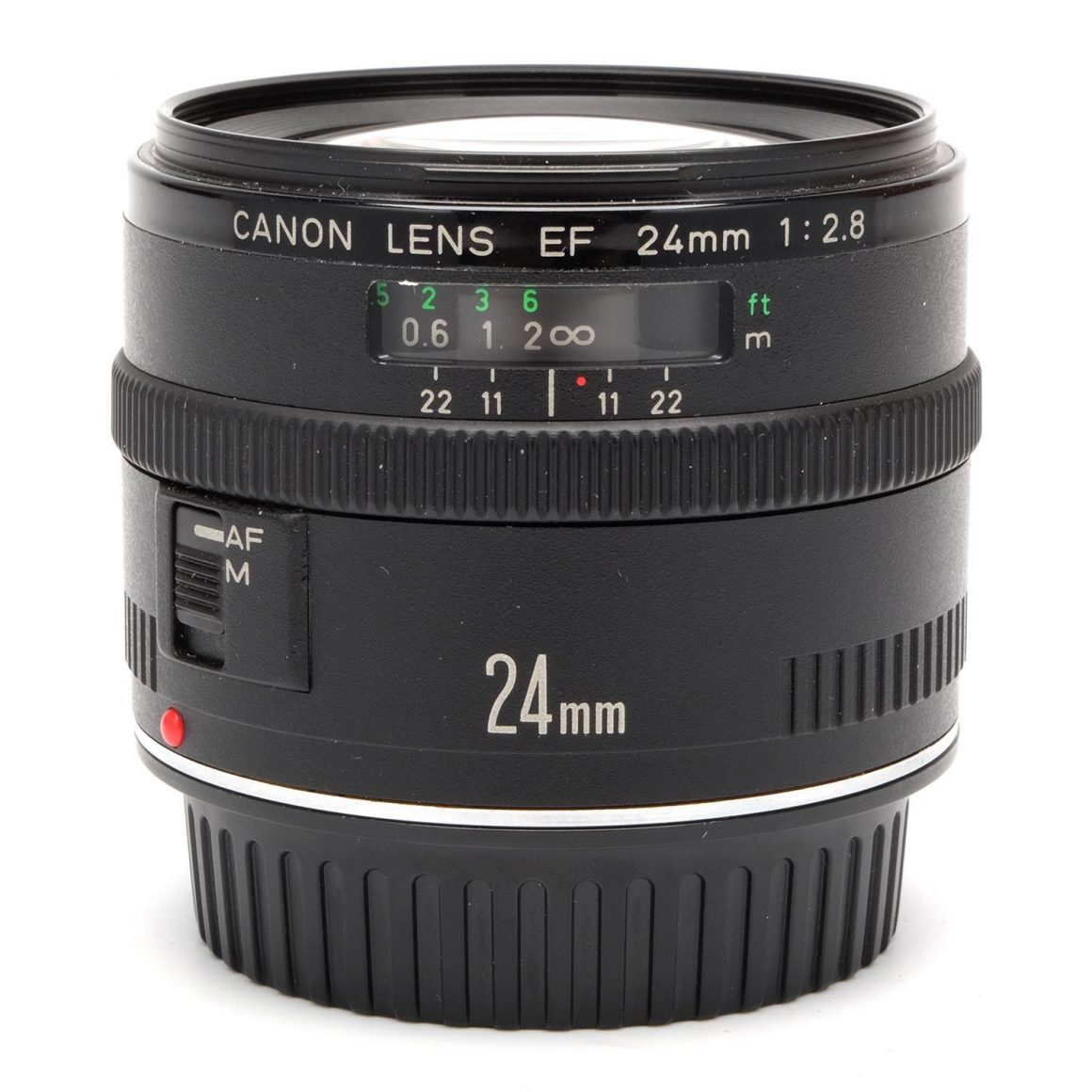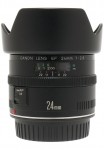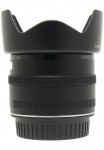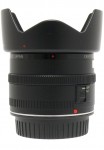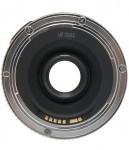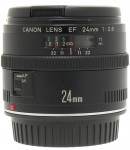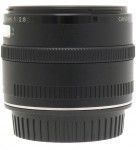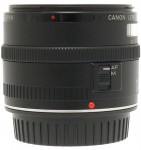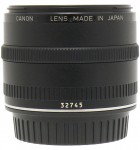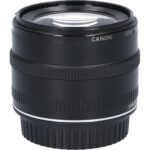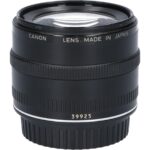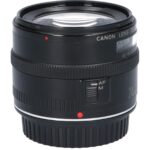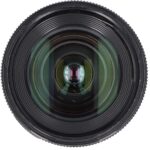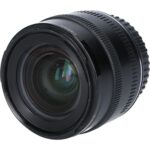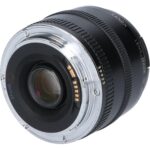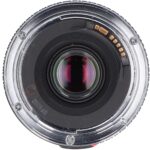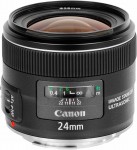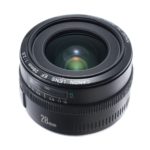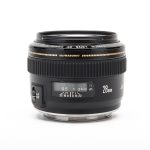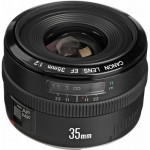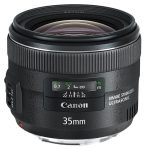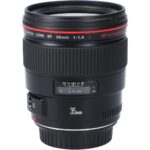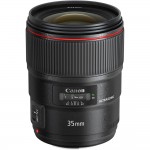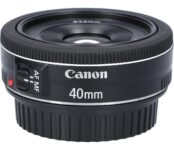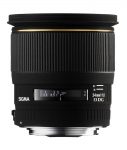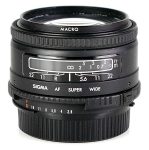Canon EF 24mm F/2.8
Wide-angle prime lens • Film era • Discontinued
- Announced:
- · November 1988
- Production status:
- ● Discontinued
- Country of design:
- · Japan
- Original name:
- · CANON LENS EF 24mm 1:2.8
- Class:
- · Fast full-frame wide-angle prime lens
- System:
- · Canon EOS (1987)
Abbreviations
| EF | The lens is designed for Canon EOS 35mm SLR cameras but can be also used on Canon EOS APS-C digital SLR cameras. |
Model history (2)
| ■Canon EF 24mm F/2.8 | A | 10 - 10 | 0.25m | ⌀58 | 1988 ● | |
| ■Canon EF 24mm F/2.8 IS USM | A | 11 - 9 | 0.20m | ⌀58 | 2012 ● | |
Specification
| Optical design: | |
| 35mm full frame | |
| 24mm | |
| F/2.8 | |
| 10 elements in 10 groups | |
| Internal focusing (IF) | |
| Floating element system | |
| Canon EF [44mm] | |
| 84° (35mm full frame) | |
| On Canon EOS APS-C [1.59x] cameras: | |
35mm equivalent focal length: | 38.2mm (in terms of field of view) |
35mm equivalent speed: | F/4.5 (in terms of depth of field) |
Diagonal angle of view: | 59.1° |
| Diaphragm mechanism: | |
Diaphragm type: | Automatic |
Aperture control: | None; the aperture is controlled from the camera |
| 6 (six) | |
| Focusing: | |
| 0.25m | |
| 1:6.25 | |
Focusing modes: | Autofocus (AF), Manual focus (M) |
Autofocus motor: | Arc-Form Drive |
Manual focus control: | Focusing ring |
Focus mode selector: | AF - M |
Full-Time Manual Focus (FTM): | - |
| Image Stabilizer (IS): | |
| - | |
| Physical characteristics: | |
| 270g | |
| ⌀68×49mm | |
| - | |
| - | |
| Accessories: | |
| Screw-type 58mm | |
| EW-60II - Bayonet-type petal-shaped | |
| Not compatible |
Source of data
- Manufacturer's technical data.
Manufacturer description #1
The EF 24mm f/2.8 is surprisingly compact and light. AF speed is exceptional, due to cam-driven rear group focusing and Canon's high-performance Arc Form Drive (AFD) focusing motor. The optical performance of this lens is characterized by excellent sharpness and contrast at all apertures. Lens handling is improved by a stationary front group, which features a non-rotating 58mm filter thread.
Manufacturer description #2
The EF 24mm f/2.8 is the widest true wide angle lens in the EF series. It has a relatively large maximum aperture that is very difficult to achieve with zoom lenses, and optical performance to satisfy the discerning photographer. The focal length is quite short, but still easy to handle without the exaggerated effects of super wide lenses in the sub-20mm range. Experience with the FD series indicates that 24mm is one of the most desired focal lengths on the wide end of the scale.
Features:
- Rear group focusing gives the advantage of a floating element also. The image stays razor sharp throughout the focusing range, with image quality even better than the FD 24mm f/2.8 unit focusing lens with a floating element.
- In addition to the optical benefits, rear group focusing is fast (0.3 seconds) and quiet.
External Design
The lens is designed with flowing lines and a pebble-grain finish to complement the design of present and future EOS cameras.
Technical Details
Cam Drive rear group focusing
Focusing of the rear group of elements uses a cam sleeve like a zoom lens rather than a heavy double helicoid. Since it focuses the smaller rear elements, it requires far less torque than if the entire lens, incuding the large, heavy front elements, were focused.
Optical Performance
This lens does not use unit focusing with a floating element in the rear as the FD 24mm f/2.8 did, but it achieves the same, in fact better, effect by using rear element focusing.
Floating element design, where the spacing between internal elements is changed as the lens is focused at near distances, corrects aberrations that tend to increase as the subject distance decreases. In this design, the rear group only moves during focusing. This changes spacing between internal elements as the lens focuses thus achieving aberration correction like a floating element.
Manufacturer description #3
A wide-angle lens reputed from its wide range of application and ease of use. Like the EF 20mm f/2.8 USM, an originally-designed near focusing optical system moves the rear lens group internally to focus the subject and provide a floating effect for maximum aberration compensation. Lens drive control is carried out by a high-precision cam-type rear focus system which corrects astigmatism at close shooting distances and realizes sharp, stable picture quality throughout the focus range. High-speed, high precision autofocusing is also realized.
Manufacturer description #4
Incorporation of rear focusing superbly compensates for all aberrations at any shooting distance, including extreme close-up, achieving very clear images. Since the length of the lens is always the same and the hood and filter mounts are designed not to rotate, operability with circular polarizing filters is sublime. Compact and easy to use, this is a fast, accurate autofocusing lens with unrivalled maneuverability.
Manufacturer description #5
The Canon EF 24mm f2.8 wide angle lens produces a wider perspective than a 28mm lens without the distortion associated with extreme wide angle lenses. This lens design also provides extremely fast autofocus operation: 0.3 sec. from minimum focusing distance to infinity.
Rear element focusing system with floating design for unsurpassed image quality, particularly at short distances.
From the editor
One of the first lenses for the Canon EOS system (please refer to the article dedicated to the Canon EF 50mm F/1.8 lens for more information on family of Canon’s lenses introduced in 1987-1990). The lens was popular for many years simply because there were no other choices if the photographer required a wide-angle prime lens with focal length of 24mm. Two years later the company introduced the Canon EF 20-35mm F/2.8L lens (1989) - a professional wide-angle zoom lens with superb image quality and combination of focal length of 24mm and speed of 2.8 in its focal length range. Canon EF 24mm F/2.8, however, was much more affordable at that time compared to the mentioned 20-35/2.8L zoom lens.
Lenses like Canon EF 24mm F/2.8 are among the best choices when you need cheapest entry-level wide-angle lens for shooting landscapes and architecture, but in terms of available and low-light shooting the Canon EF 24mm F/1.4L II USM lens should be a more ideal choice.
Compared to other wide-angle prime lenses in the Canon EOS system
- Slowest speed (F/2.8), along with 4 other models
Other wide-angle prime lenses in the Canon EOS system
| ■Canon EF mount (11) | |||||||||
| Canon EF 24mm F/2.8 IS USM • ⌀58 | 2012 ● | compare | 3 | 0 | |||||
| Canon EF 24mm F/1.4L USM • ⌀77 | Pro | 1997 ● | compare | 3 | 3 | ||||
| Canon EF 24mm F/1.4L II USM • ⌀77 | Pro | 2008 ● | compare | 5 | 3 | ||||
| Canon EF 28mm F/2.8 • ⌀52 | 1987 ● | compare | 1 | 1 | |||||
| Canon EF 28mm F/2.8 IS USM • ⌀58 | 2012 ● | compare | 3 | 0 | |||||
| Canon EF 28mm F/1.8 USM • ⌀58 | 1995 ● | compare | 3 | 0 | |||||
| Canon EF 35mm F/2 • ⌀52 | 1990 ● | compare | 2 | 1 | |||||
| Canon EF 35mm F/2 IS USM • ⌀67 | 2012 ● | compare | 4 | 3 | |||||
| Canon EF 35mm F/1.4L USM • ⌀72 | Pro | 1998 ● | compare | 3 | 3 | ||||
| Canon EF 35mm F/1.4L II USM • ⌀72 | Pro | 2015 ● | compare | 7 | 3 | ||||
| Canon EF 40mm F/2.8 STM • ⌀52 • Pancake lens | 2012 ● | compare | 6 | 1 | |||||
Lenses with similar focal length
| ■Canon EF mount (3) | |||||||||
| Sigma 24mm F/1.8 EX DG Aspherical Macro • ⌀77 | 2000 ● | compare | 2 | 3 | |||||
| Sigma Super Wide 24mm F/2.8 II • ⌀52 akaQuantaray Tech-10 AF 24mm F/2.8 |
1988 ● | compare | 0 | 1 | |||||
| Sigma 24mm F/1.4 DG HSM | A • ⌀77 | Pro | 2015 ● | compare | 5 | 4 | ||||
